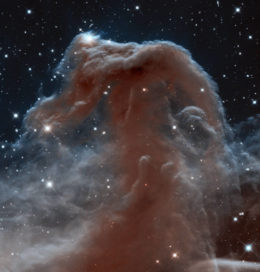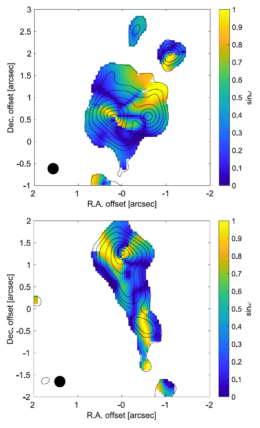Deep within giant molecular clouds, hidden by dense gas and dust, stars form. Unprecedented data from the Atacama Large Millimeter/submillimeter Array (ALMA) reveal the intricate magnetic structures woven throughout one of the most massive star-forming regions in the Milky Way.
How Stars Are Born

The Horsehead Nebula’s dense column of gas and dust is opaque to visible light, but this infrared image reveals the young stars hidden in the dust. [NASA/ESA/Hubble Heritage Team]
How can we learn about the magnetic fields of distant objects? One way is by measuring dust polarization. An elongated dust grain will tend to align itself with its short axis parallel to the direction of the magnetic field. This systematic alignment of the dust grains along the magnetic field lines polarizes the dust grains’ emission perpendicular to the local magnetic field. This allows us to infer the direction of the magnetic field from the direction of polarization.

Magnetic field orientations for protostars e2 and e8 derived from Submillimeter Array observations (panels a through c) and ALMA observations (panels d and e). Click to enlarge. [Adapted from Koch et al. 2018]
Tracing Magnetic Fields
Patrick Koch (Academia Sinica, Taiwan) and collaborators used high-sensitivity ALMA observations of dust polarization to learn more about the magnetic field morphology of Milky Way star-forming region W51. W51 is one of the largest star-forming regions in our galaxy, home to high-mass protostars e2, e8, and North.
The ALMA observations reveal polarized emission toward all three sources. By extracting the magnetic field orientations from the polarization vectors, Koch and collaborators found that the molecular cloud contains an ordered magnetic field with never-before-seen structures. Several small clumps on the perimeter of the massive star-forming cores exhibit comet-shaped magnetic field structures, which could indicate that these smaller cores are being pulled toward the more massive cores.
These findings hint that the magnetic field structure can tell us about the flow of material within star-forming regions — key to understanding the nature of star formation itself.

Maps of sin ω for two of the protostars (e2 and e8) and their surroundings. [Adapted from Koch et al. 2018]
Guiding Star Formation
Do the magnetic fields in W51 help or hinder star formation? To explore this question, Koch and collaborators introduced the quantity sin ω, where ω is the angle between the local gravity and the local magnetic field.
When the angle between gravity and the magnetic field is small (sin ω ~ 0), the magnetic field has little effect on the collapse of the cloud. If gravity and the magnetic field are perpendicular (sin ω ~ 1), the magnetic field can slow the infall of gas and inhibit star formation.
Based on this parameter, Koch and collaborators identified narrow channels where gravity acts unimpeded by the magnetic field. These magnetic channels may funnel gas toward the dense cores and aid the star-formation process.
The authors’ observations demonstrate just one example of the broad realm ALMA’s polarimetry capabilities have opened to discovery. These and future observations of dust polarization will continue to reveal more about the delicate magnetic structure within molecular clouds, further illuminating the role that magnetic fields play in star formation.
Citation
Patrick M. Koch et al 2018 ApJ 855 39. doi:10.3847/1538-4357/aaa4c1


3 Comments
Pingback: making stars: gravity and magnetism
Pingback: Magnetic field, gravity, star birth
Pingback: No ‘forno prebiótico’ da primitiva ‘Era habitável’ | Questões Cosmológicas